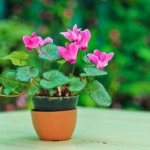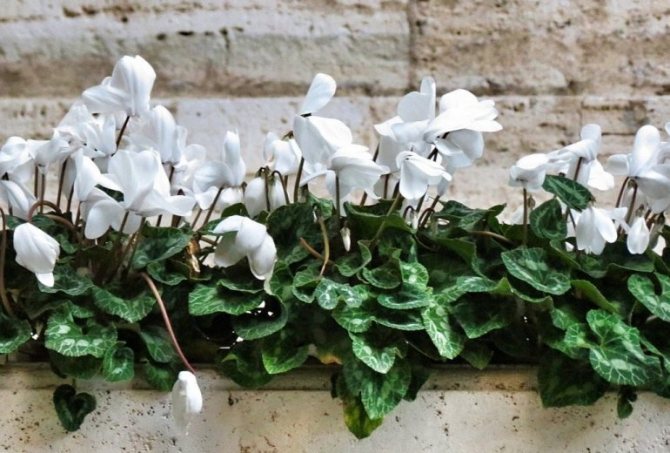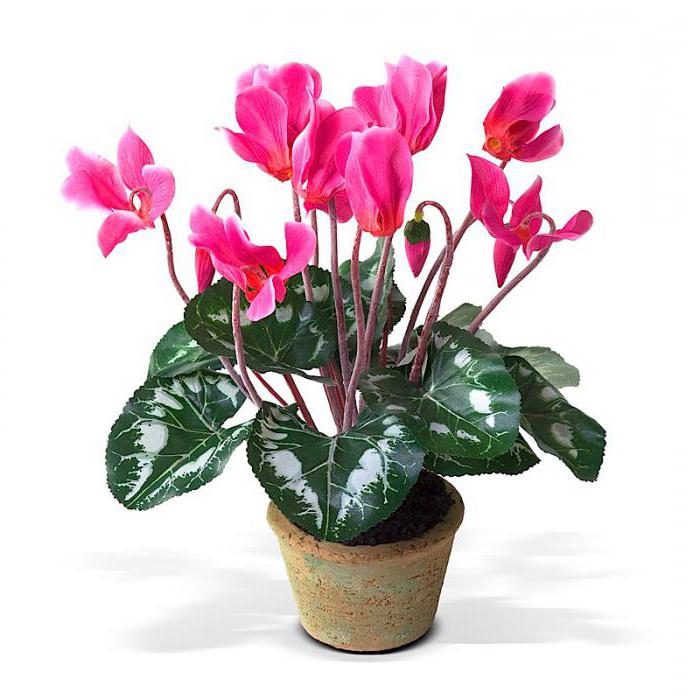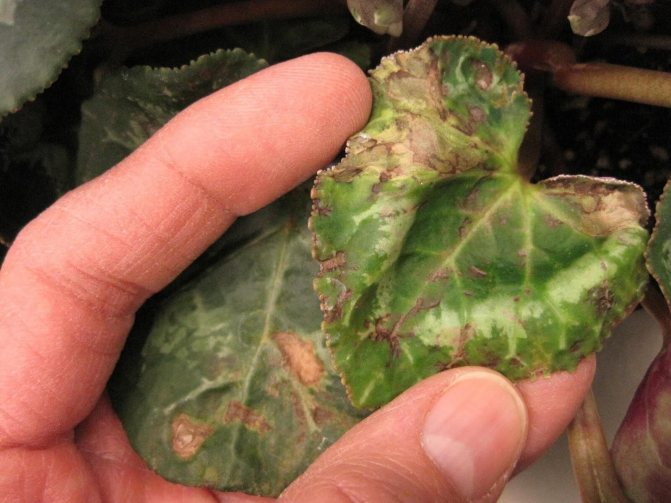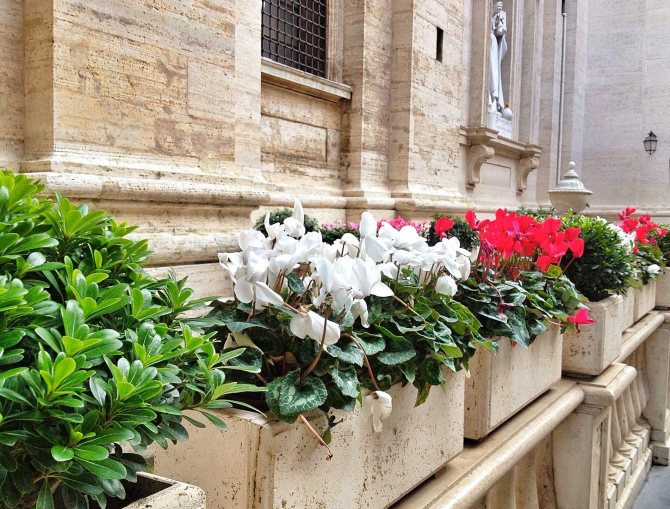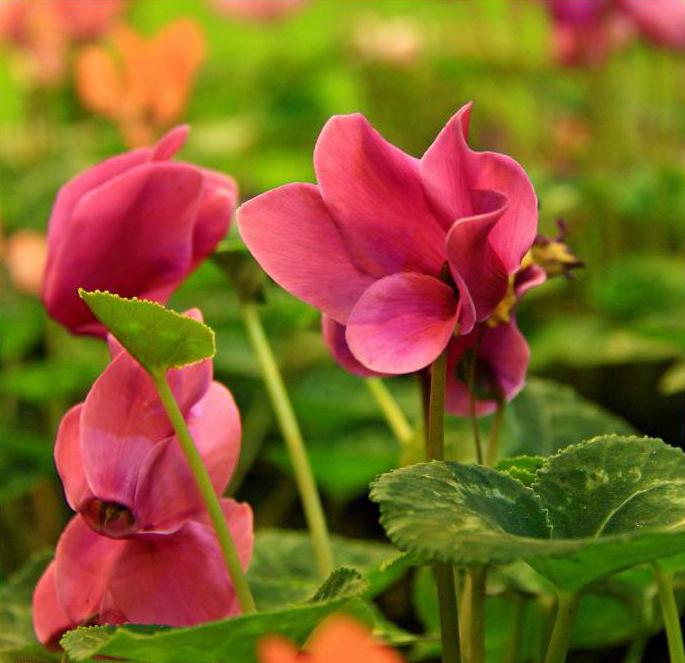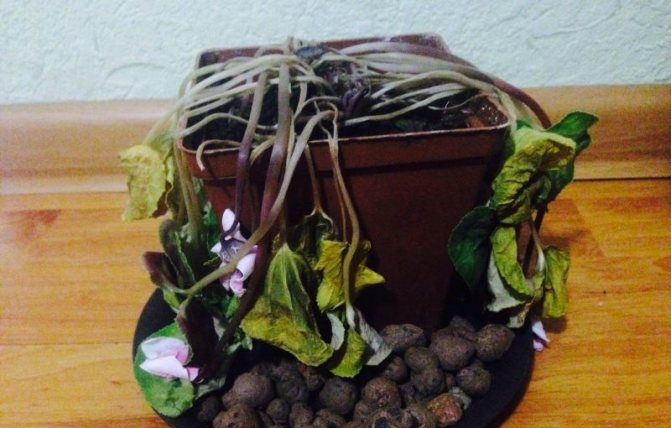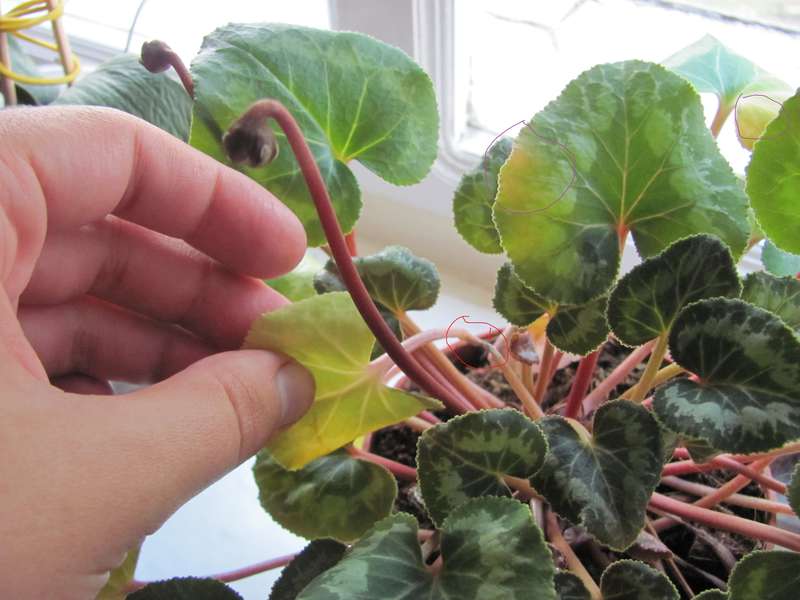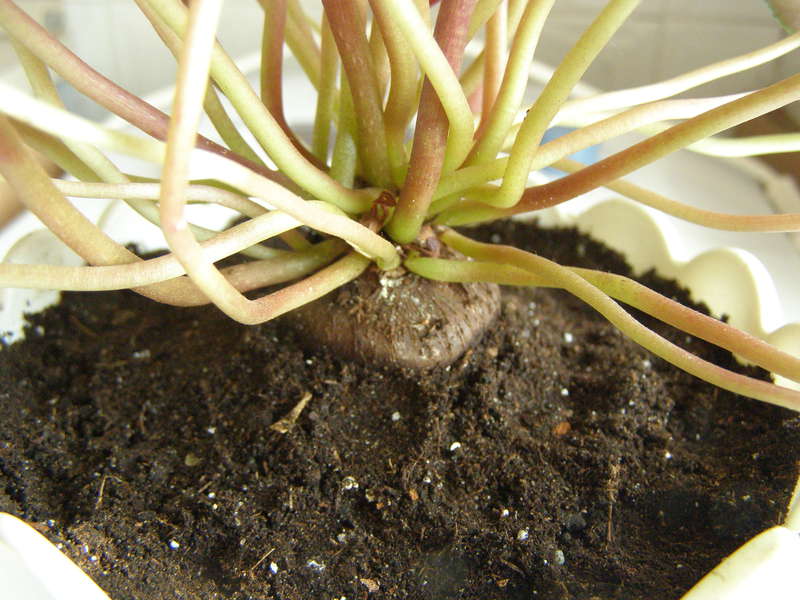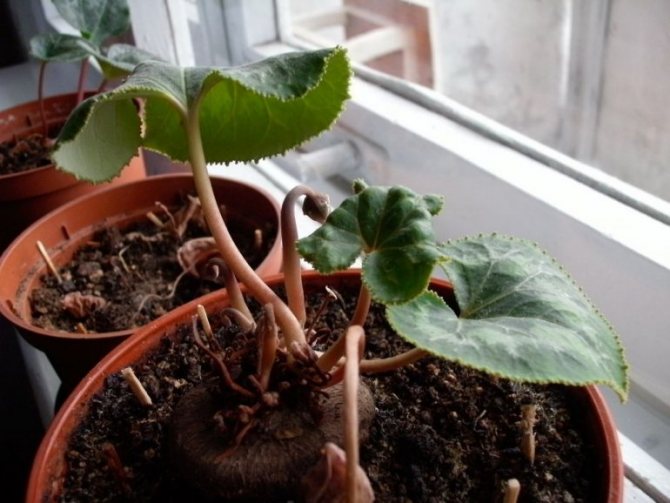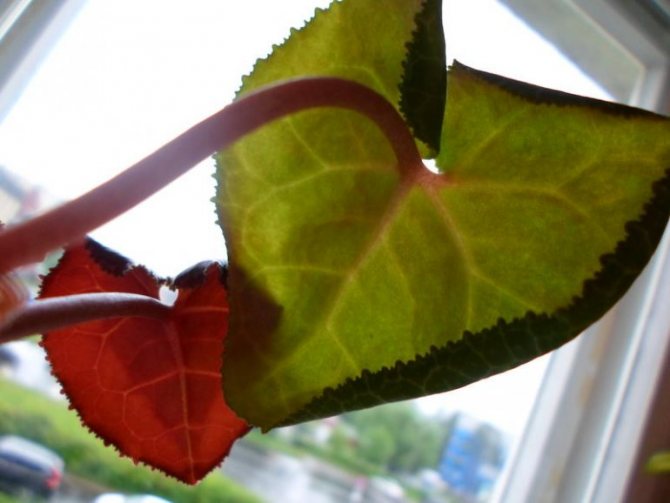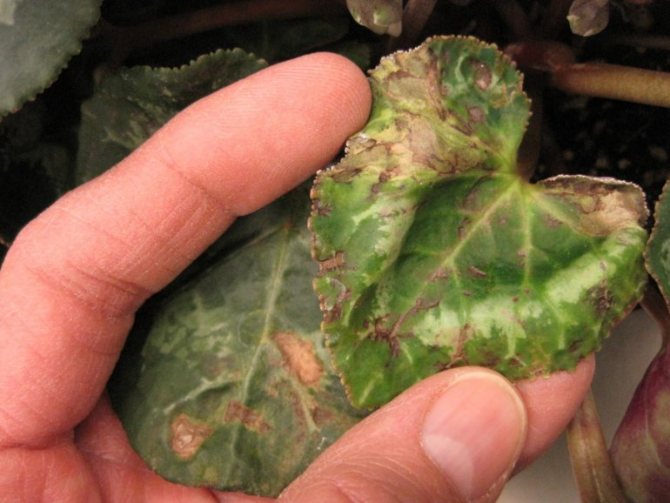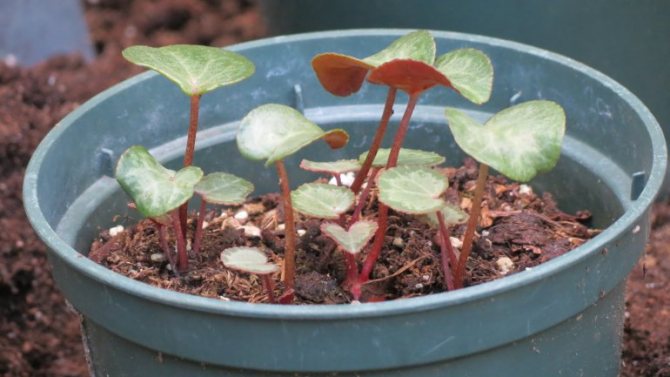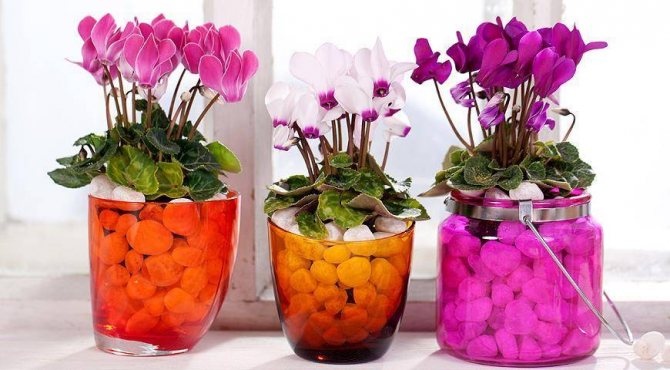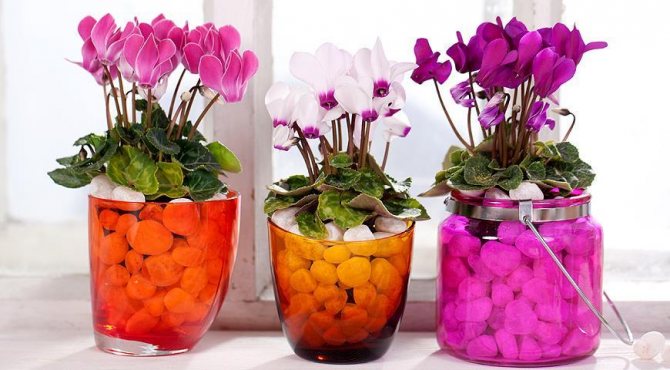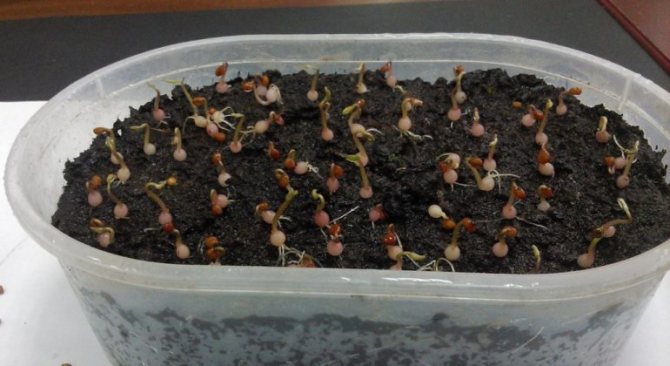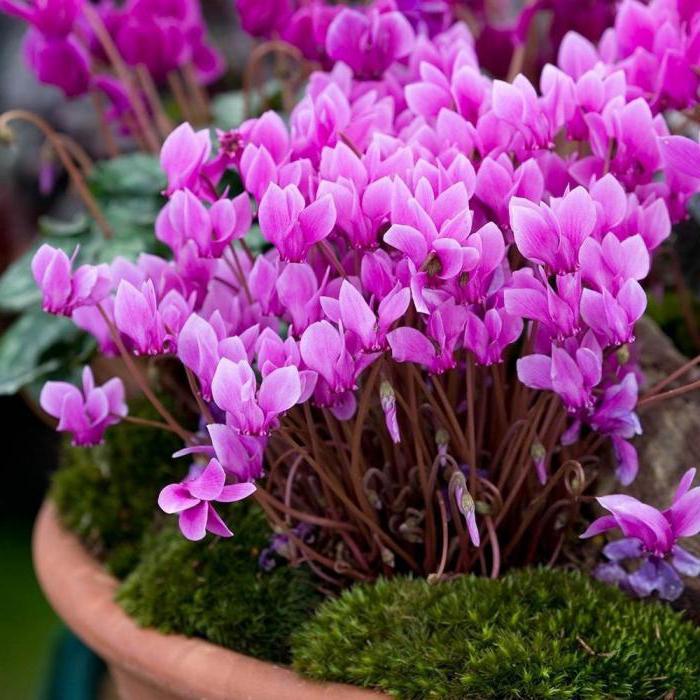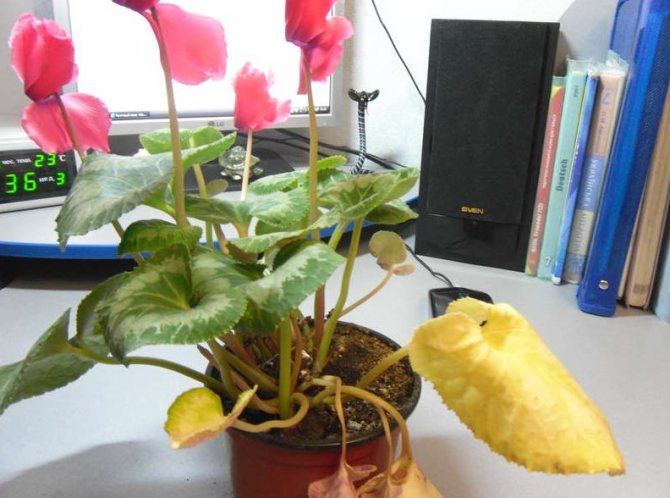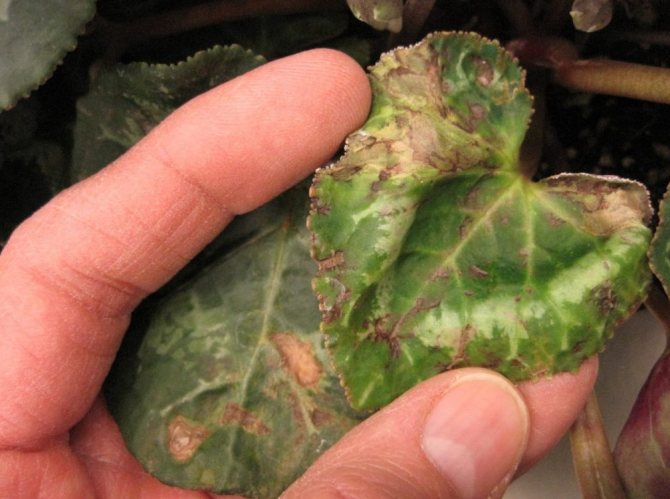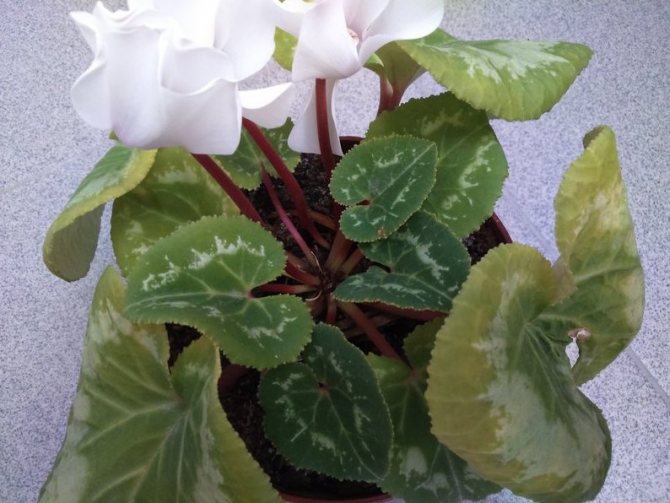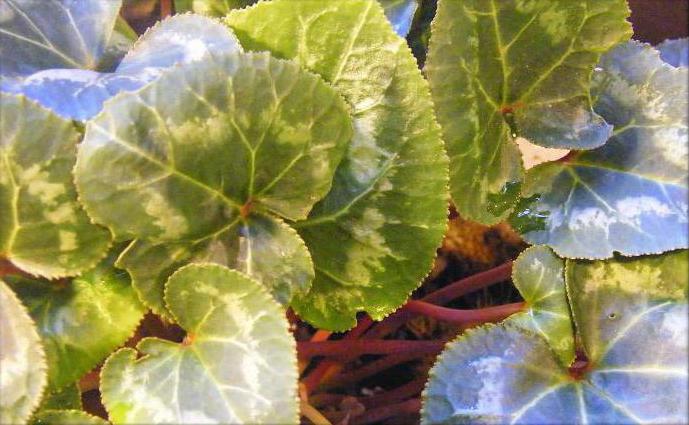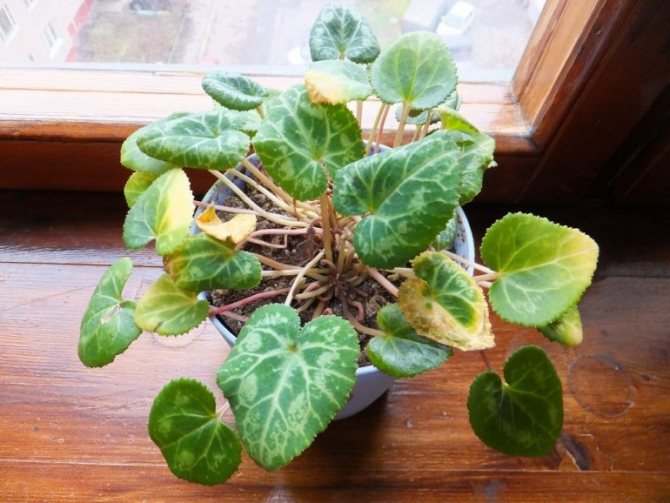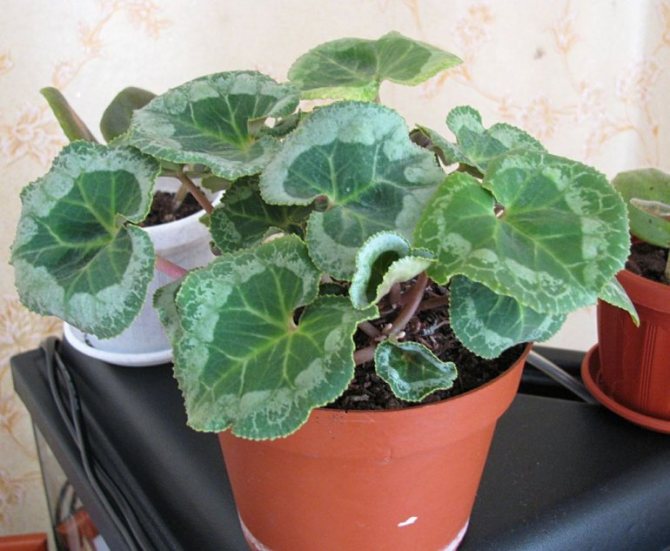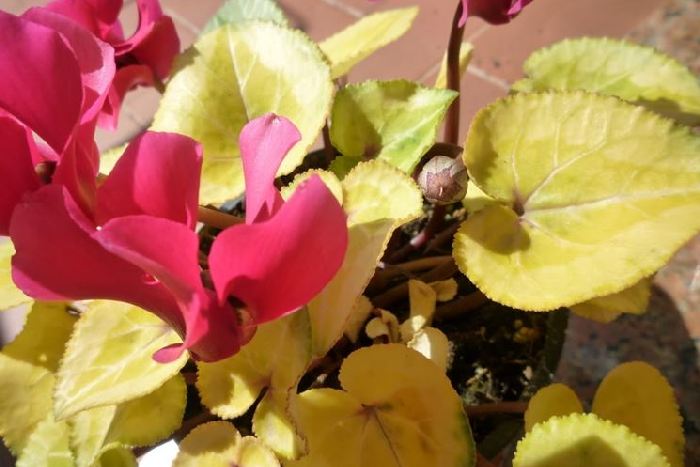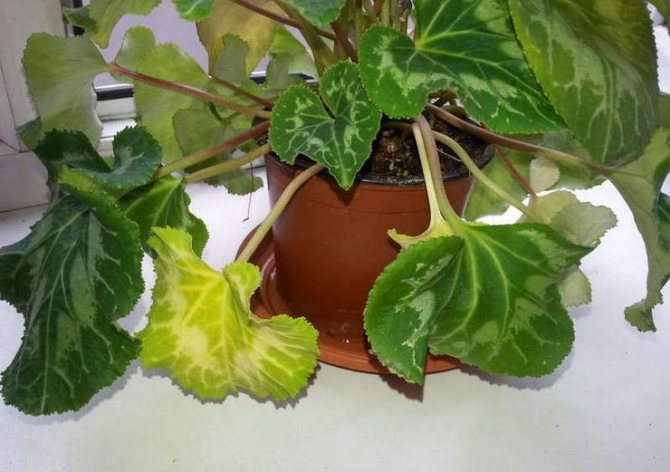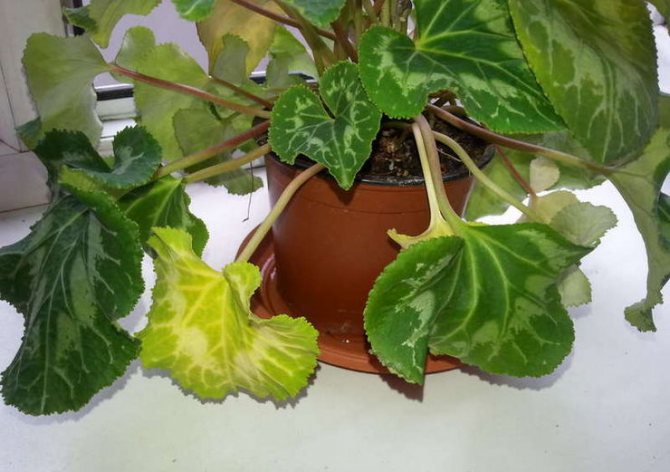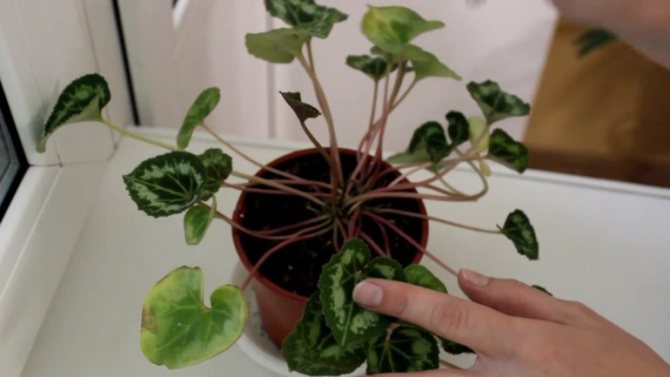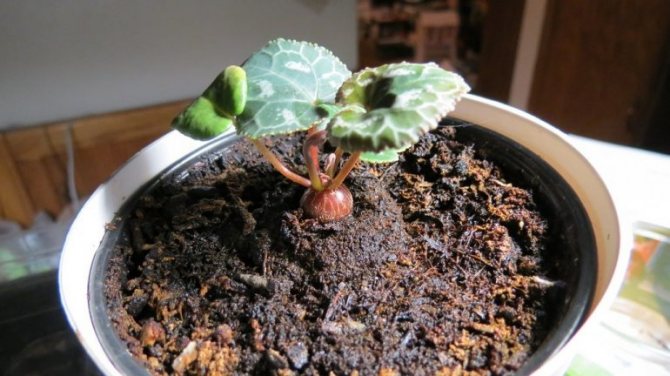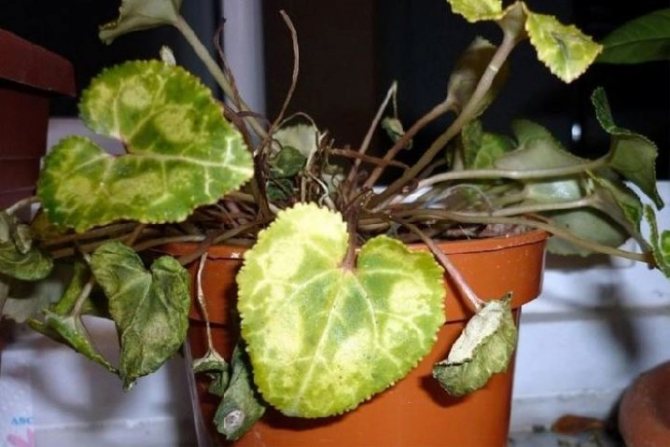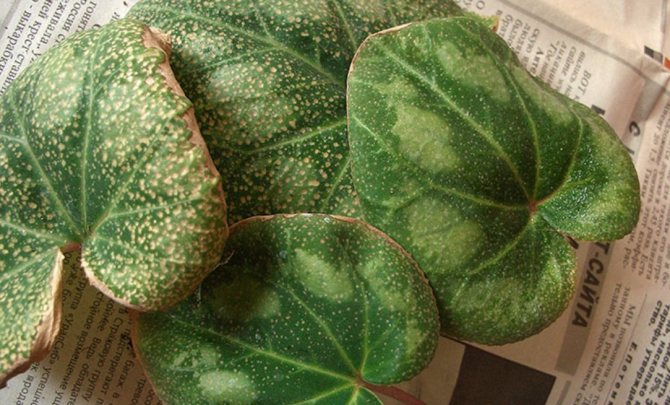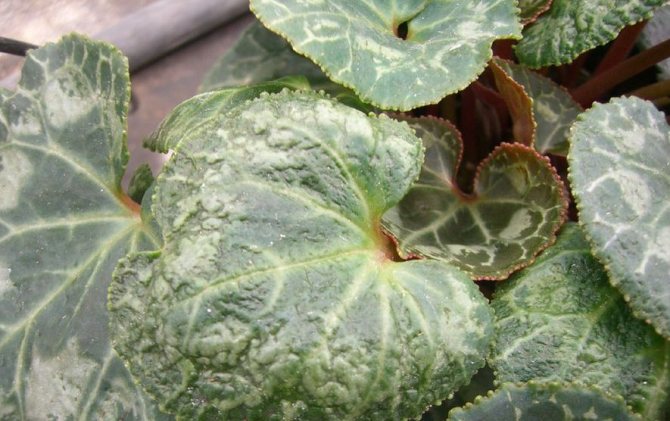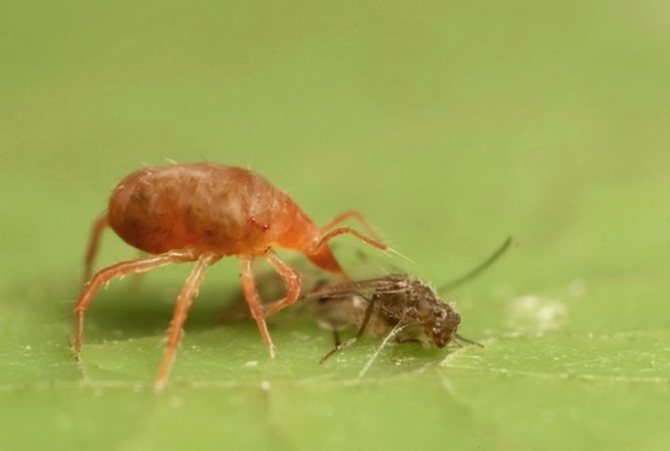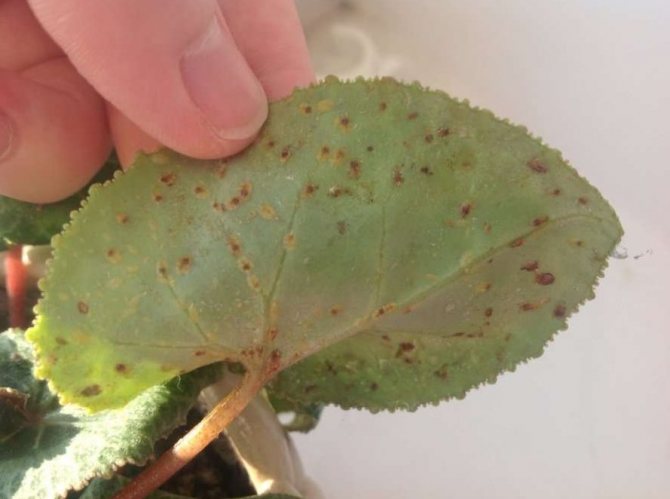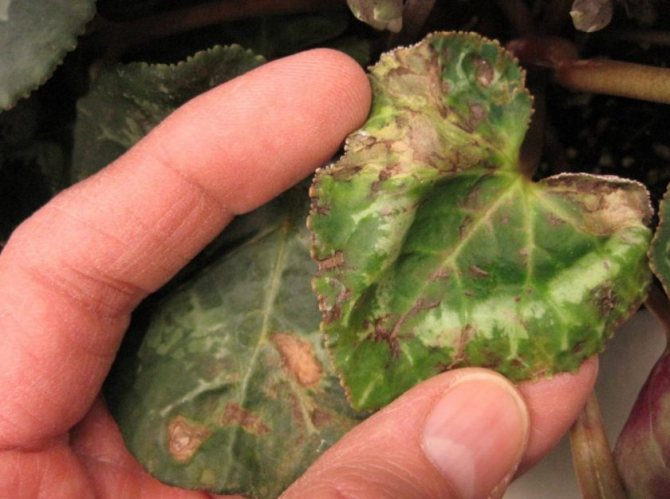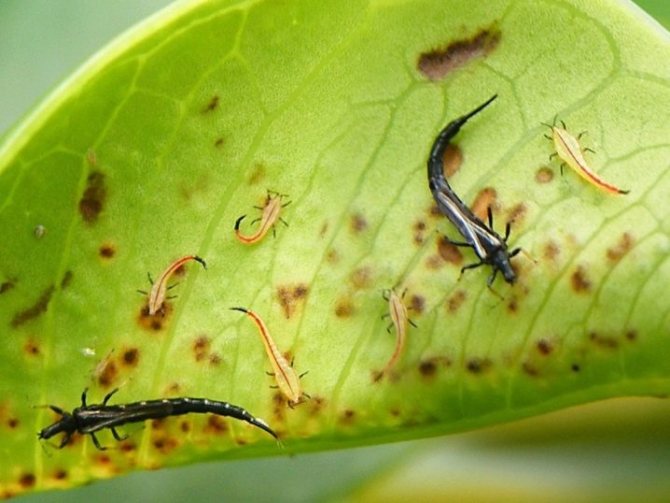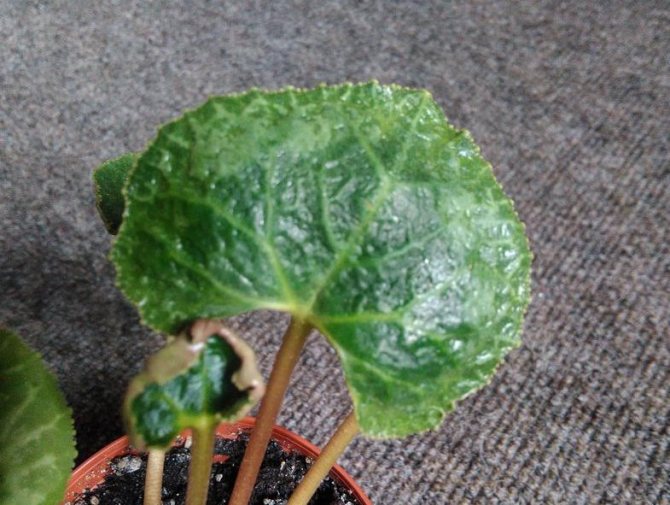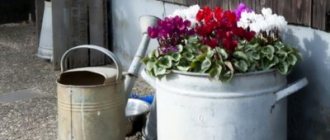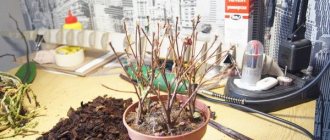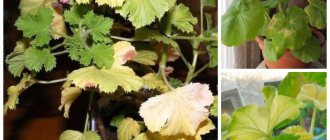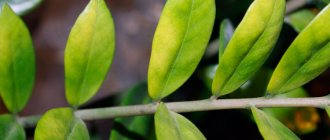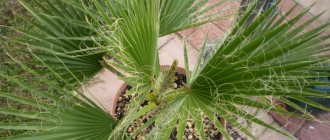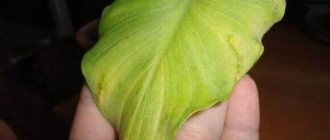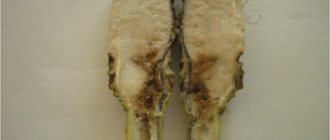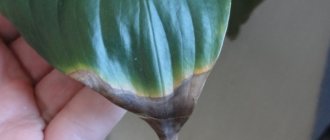Cyclamen is considered a capricious plant. But this did not stop him from winning the hearts of Russians and firmly taking places on their windowsills. For large, bright flowers that bloom in the middle of winter, flower growers are ready to create ideal conditions for him... In any others, it can begin to show character: it will stop blooming, it will begin to shed quickly yellowing leaves. How to find out what the plant is dissatisfied with and what can be done to save cyclomia from death and will be discussed in this article.
Growth features
As a home plant, two types of cyclamen are often used - European and Persian. To grow any of them, you need to work hard, since the alpine violet is very finicky. Often, novice growers complain that the flower quickly turns yellow and withers. To prevent this from happening, you need to know about caring for the plant from the very beginning, that is, with the choice of a flower when buying it.
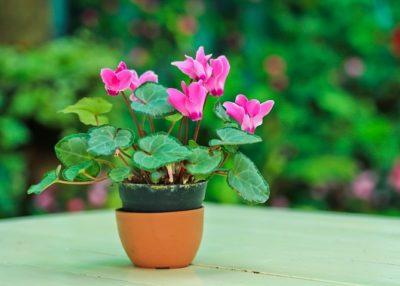
Take a close look at the tubers first. They should be free of damage and rot, they should be smooth, and the leaves should be shiny and bright. If the foliage of the cyclamen is sluggish or dry, then this indicates a flower disease. Therefore, buy a flower in the autumn, when there is already flowering and it is possible to determine whether the plant is healthy.
Having brought home a flower, you must be able to properly care for it. Otherwise, it will lose its previous appearance, the leaves will begin to turn yellow or wither. An important role is played by the temperature regime in the room. So, if you notice yellowed edges on the leaves, then the air in the room with the flower is too dry. So you need to increase the humidity in the room.
For a flower, the most comfortable temperature is 17 ºС, no more. Alpine violet does not tolerate direct sunlight or lack of moisture. These factors affect the inflorescences, flowering becomes rare and not so lush. If watering is regular, and frequent feeding, then the cyclamen will delight you with its flowers again and again.
Growing conditions
Most of all flower growers are worried that the leaves of cyclamen turn yellow. What if this happened? In order to avoid such problems, you should know about the necessary conditions for the safe growth of this plant.
Cyclamen is very fond of rooms with bright lighting, but direct sunlight is undesirable for him. In winter, a bright room with an air temperature of no more than 12 degrees is recommended for the plant.
The domestic flower cyclamen European (purple) does not have a clear dormancy period, and, as a rule, they do not winterize it, although it would not hurt. This is the difference between this species and the alpine violet (Persian cyclamen), in which, after the flowering period (in May-June), leaves begin to shed. She goes to rest.
The best place in the house for cyclamens is the west and east windows. When the plant is on the south side, you should protect it from the sun's rays. It is also important to regularly ventilate the premises.
Diseases
The reason for the wilting of the flower can be associated with a number of diseases:
- The presence of gray rot. First, a whitish bloom forms on the leaves, which eventually develops into brown soft spots. The infected flower is transplanted into new soil and treated with a fungicide.
- Disease late blight rot. There is a gradual drying of the lower leaves and peduncles, then the disease passes to the tubers. Treatment is based on replanting the plant and treating the soil with a fungicide.
- Fusarium. Yellowing and gradual drying of cyclamen occurs. The disease has not been detected for a long time, since the tuber does not give itself out in anything, it is the same as usual. To save a flower, you need to water it with water with the addition of funzol.
Read about other common cyclamen diseases, how to recognize them and how to deal with them here.
What to do if the leaves and flowers have withered - detailed instructions:
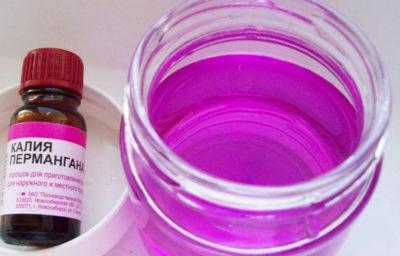

To prevent diseases from overwhelming the plant, the usual sterilization of the soil will help.- Water the soil periodically with a mild manganese solution. It will eliminate bacteria and fungi that are common in the soil.
- Don't overdo it with nitrogen fertilizers. If there is an excess of this substance in the soil, the plant's immunity will become too weak, and the flower will be very susceptible to any kind of infection.
- Excess moisture and low temperature in the room contribute to cyclamen wilting. Therefore, you should fight these shortcomings, otherwise you risk losing your flower. Learn more about how to save a flooded cyclamen here.
- Rot, as has already been found out, appears on the leaves due to various diseases.
The foliage turned yellow during flowering, what should I do?
To solve this problem you need, first of all, to reconsider the conditions for keeping an indoor flower:
- It is necessary to pay attention to the room temperature, which should not exceed + 16 ° С. If necessary, you need to remove the flower away from heating devices or take it to a colder room.
- You need to pay attention to lighting: cyclamen needs diffused bright light, but direct sunlight is not desirable.
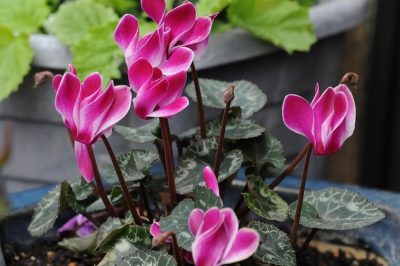

It is also necessary to control the irrigation regime and the level of humidity in the room. During flowering, cyclamen needs regular, but not too abundant watering. The procedure for humidifying the air should be repeated several times during the day with a fine spray, in no case getting on the leaves and open buds.- If the flower was attacked by pests, then it is necessary to treat it with insecticides: Aktellik, Fitoverm. You will learn about all pests and methods of dealing with them here.
How to save?
You can try to save the plant by taking the following emergency measures:
- Change the place for the pot. Move it to another room where the conditions are up to standard.
- Spray the butterfly flower with a stimulant. Usually this may be needed after buying a flower and adapting it to new conditions.
- Add extra food to the cyclamen pot.
- If you see an obvious disease or have noticed pests, then dig up the tuber, free it from the remnants of the earth and transplant the flower into good fertilized soil.
- The leaves can be treated with a medicine that is used for pest control. To have a positive effect, do this several times after a certain number of days. Approximately every 3-5 days.
Read about how to save a cyclamen if it dies here.
Reproduction of cyclamen
Cyclamens are best propagated by seeds, but this requires a lot of patience, due to the fact that this is a rather laborious job. It takes a lot of time and energy. To begin with, it should be borne in mind that each variety has an individual ripening time.
To obtain seeds on your own, you need to artificially dust the cyclamen. The optimal period for planting is winter or early autumn. If you buy seeds in a store, you need to pay special attention to the production date - the seeds should not be more than 2 years old, otherwise there will be no germination.
Before planting seeds, they must be left overnight in a weak solution of potassium permanganate.The soil must be loose and must be steamed. The soaked seeds should be deepened 1 centimeter into the treated soil and covered with polyethylene. Place the container away from bright lighting. Seeds will germinate in 30-45 days. Throughout this period, you need to periodically water and ventilate the room. Only a year and a half after planting the seedlings in a pot, the first flowers will appear on the plant.
Tuber propagation of cyclamen is not a very good way. Unfortunately, the structure of the tuber is designed in such a way that the slightest damage contributes to its decay, especially in winter.
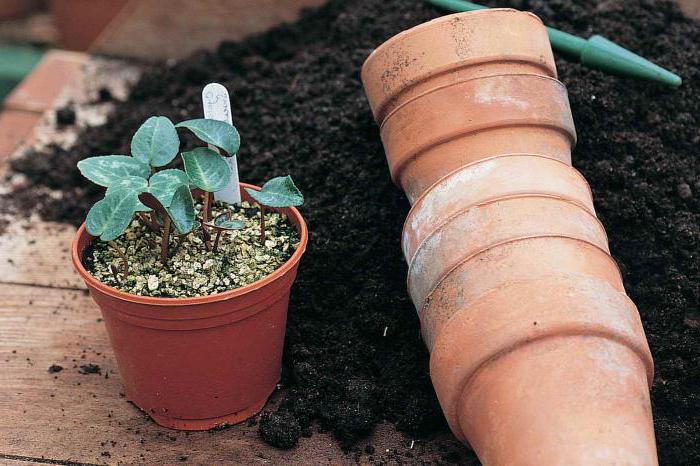

Preventive measures
In order to prevent the plant from wilting or other negative consequences, it is worth taking preventive measures, or knowing how to properly care for this variety of indoor flowers:
- The room where the plant is located should be cool. If the air temperature in the room is kept within + 6 ... + 12 ° С, then the cyclamen can bloom up to six months.
- You should not make the lighting too bright, it is better to try to make it diffuse.
- The soil must be prepared loose, with a weak reaction and good drainage, for example, ready-made for plants such as violets is suitable.
- Do not pick up a large and deep pot.
- A cyclamen transplant is done once every 2-3 years, while the capacity should be chosen more than the previous one.
- Planting depth will depend on the type of plant.
You should not bring the flower to a state where it will require emergency assistance. In order for the cyclamen to grow and bloom normally, it is necessary to fulfill the minimum amount of care requirements. If you follow all the rules, then the cyclamen will grow on average for another 15 years and delight households with its lush flowering.
If you find an error, please select a piece of text and press Ctrl + Enter.
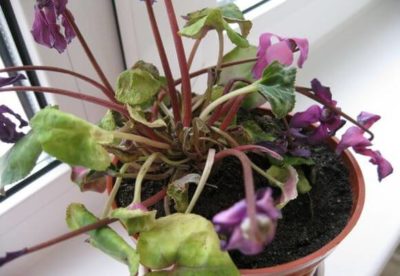

Cyclamen is a beautiful perennial plant of the Primrose family. It has fragile and unusual inflorescences that adorn any home. However, sometimes flower growers are faced with a fairly common problem - cyclamen does not bloom and withers. What to do in this case and how to save the plant from death?
Next, we will tell you how to prevent the flower from wilting and drying of its leaves. How to identify diseases in the early stages. How to save a flower.
Soil and fertilizing
It also happens that the leaves of the cyclamen curl. What to do? Incorrect feeding and poor-quality soil composition are of considerable importance in this case. It is necessary to create good aeration for the cyclamen roots. To do this, when planting a plant, use an air-permeable substrate consisting of coarse peat. The optimal composition of the soil is the same parts of humus, sand, peat and 3 parts of leafy land.
Once every two weeks, you should feed the cyclamen with a complete mineral fertilizer, usually used for flowering plants, or organic matter. Moreover, this must start with the development of leaves and continue throughout the entire flowering period.
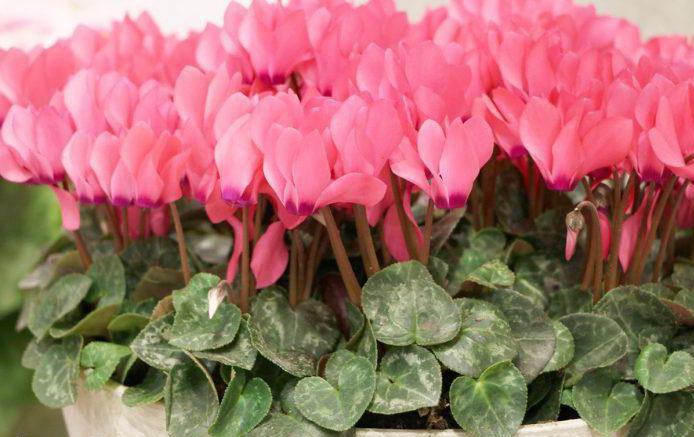

Why does the problem occur and how to fix it?
Leaves dry
Cyclamen leaves wither for various reasons. This is not always a cause for excitement - you just need to carefully observe the flower. If the plant slowly withers and turns yellow, gradually getting rid of old leaves, then it is time for a seasonal rest. In this case, there are no health problems. If the branches of a flower are bare in a matter of days, then the plant is sick.
A possible cause could be parasite infestation or improper care. In this case, do not despair. It is necessary to start timely treatment that will give a positive result.
Inflorescences wither
If you purchased a flower and it was healthy at the time of purchase, several factors can cause wilting:
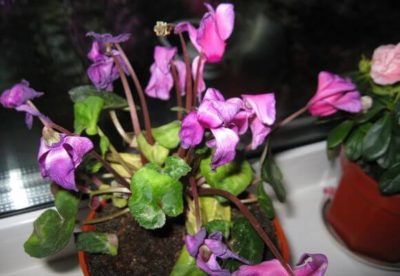

The plant is stressed due to changes in temperature and humidity.- Exhaustion.In stores, often to increase flowering and accelerate growth, flowers are fertilized with powerful stimulants and hormonal drugs.
If you decide to purchase a cyclamen, then when buying a plant, carefully examine the flower. The soil should be mold-free, uniform and free of rotten leaves. You should also check the inside of the leaves - they should be pest-free and not twisted.
Also, the flower you usually like is placed in the brightest place, closer to the window. Too often sprayed and watered (how to save a flooded cyclamen?). This can cause the leaves and flowers to dry out.
Another reason for the drying out of leaves and flowers is parasite infestation.
Why leaves turn yellow - all kinds of reasons
Cyclamen leaves periodically turn yellow - this problem is sometimes encountered by the mistress of the plant. The reason for the yellowing of the leaves is usually improper care and violation of the conditions of detention.
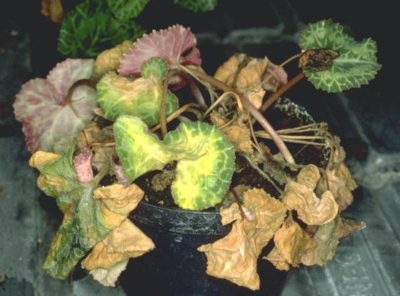

A possible cause of yellowed leaves of a house flower could be:
- Unsuitable temperature. Cyclamen belongs to cold-loving plants, therefore it does not tolerate high temperatures. He feels comfortable at temperatures ranging from + 14C to + 16C.
- Incorrect lighting. Insufficient lighting or direct sunlight on the flower can lead to yellowing of the leaves.
- Watering and humidity errors. An excess or lack of moisture can immediately affect the plant. Cyclamen prefers humid air - too dry indoor air can cause yellowed leaves.
- Feeding errors. The absence or excessive feeding of the plant with fertilizers with a high nitrogen content can also cause yellowing of cyclamen leaves.
- Rest period. After abundant flowering, the plant prepares for rest and during this period the natural process of wilting begins: the leaves gradually turn yellow and dry.
- Delay and transplant errors. The cyclamen is transplanted just before flowering. A prepared mixture of sand, leaf humus and sod land is perfect for transplanting. The decayed part of the tuber should be removed.
From the video you will learn why the leaves of cyclamen turn yellow in winter:
Diseases
Possible cyclamen diseases can be conditionally divided into parasitic and nonparasitic. In the first case, we are talking about the harm of parasites, in the second - about improper care of the flower. The causes of nonparasitic diseases are:
- excessively moist soil;
- insufficiently humid air in the room where the plant is located;
- wrong choice of soil;
- unsuitable pot;
- the wrong choice of the location of the plant in the house.
As for diseases of a parasitic nature, it is worth mentioning such pests as aphids, cyclamen ticks and thrips.
- Cyclamen mite is microscopic in size, making it difficult to see on a flower. Parasitizes on the inside of the leaf. From the outside, it may seem that the leaves are covered with dust. When trying to shake off such "dust" difficulties arise, while the edges of the leaves begin to curl. You can get rid of the parasite with the help of chemical antiseptics.
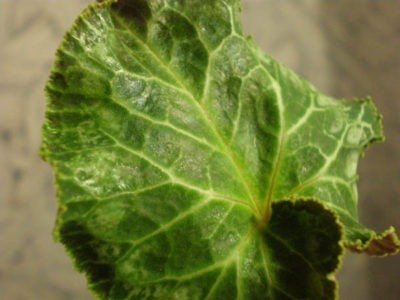

Thrips are highly active. They are very bright and can be easily identified by their silvery bloom. This adversely affects the further growth of the flower leaves. As a result, they may simply fall off. To eliminate thrips, you can use insecticides or sticky tapes.- Aphid is the most common parasite. Its appearance causes a complete deformation of the leaves and the plant itself, contributing to its depletion and taking away all the juices from it. Symptoms of aphid infestation are gray, black, white, orange, or green bloom on the leaves of the flower. To eliminate aphids, spray the cyclamen with an insecticide, and then rinse with running water.
You can read more about cyclamen diseases here, and we wrote about pests that can attack your plant in this article.
Why leaves turn yellow, and what to do with them
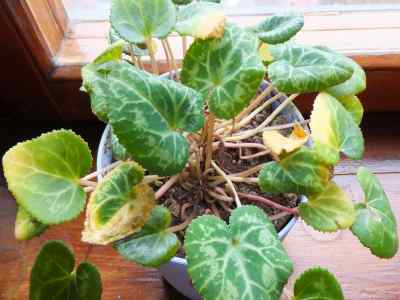

The main reason for the yellowing of cyclamen after purchase is a change in the microclimate and the usual care for it. In stores, the flower is grown like plants in a greenhouse. They are cared for and cherished: they moisten the leaves every day, feed them, and treat them against pests. But everyone does this using very poor soil. Caring for a cyclamen at home is different: it is impossible to do everything the way they did in the store. And the poor soil makes itself felt. Let's try to figure out what exactly your green pet didn't like.
Dry air
Cyclamen loves humid air. With insufficient moisture, its foliage turns yellow and withers, and flowers do not form at all.
Eliminate the cause: increase the humidity. This is especially true in winter, when the air is dry due to heating devices. For humidification, it is best to use a special humidifier. But you can get by with a large and wide capacity that you need to put on the battery. In addition, spray the leaves of the plant, but try not to get on the tuber itself: it is better to spray "nearby".
Waterlogging of the soil
If the flower is regularly poured, or if it has poor drainage (or it does not have it at all), then the roots begin to rot and they cease to cope with their work. Leaves turn yellow and wither from lack of nutrition.
What if the plant dies?
If the cyclamen flower has wilted, then first of all it is necessary to pinch off the yellowed and dried leaves, as well as dry flowers at the base.
The flower should not be kept near heating appliances., the cyclamen must be moved away from them. You should also avoid direct exposure to sunlight. In the summer, cyclamen will feel much better in a shady corner. On hot days, you can put ice on the tubers of the flower.
If it happened that the cyclamen stood in the sun for a long time, then you can put the pot in a basin with cold tap water for 1-1.5 hours. Thus, the plant will be able to revive.
Sometimes the flower begins to turn yellow and dry due to infection. To get rid of the Fuzarium fungus, it is recommended to water the ground with a 0.1% solution of foundationol or spray the plant with a 0.1% solution of Topsin-M.
Wet rot can also lead to wilting. With this type of lesion, the plant is very unpleasant, it smells foul. The bacteria enter through the cracks in the tubers. Often, infections occur through the place of separation of the leaves. Sometimes contaminated water or soil can be the cause. If your plant has been exposed to this bacteria, then it is no longer possible to save it.
Gray rot or Botrytis - causes the appearance of a gray bloom, after which the leaves begin to turn yellow quickly. The affected areas should be removed with a sharp blade and the whole plant should be treated with a fungicide.
Read more about the causes of flower death and resuscitation at home in this material.
Watering
During the flowering period when watering, you need to avoid excess moisture at the base of the root; it is best for this to pour water into a tray. Moisture must be distributed evenly, without overflow and overdrying of the soil.
During the dormant period, the Persian cyclamen should be watered less, but the land should not be allowed to dry out. The European type of cyclamen is watered equally all year round.
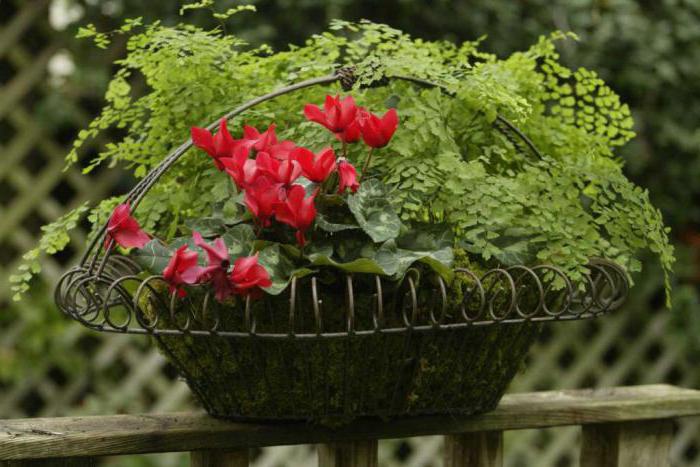

How to save in a state of disrepair?
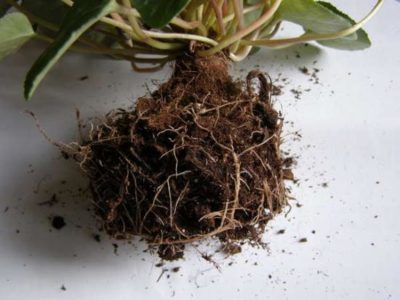

Sometimes it turns out that the plant looks withered and dead. In this case, you can try to revive it. To do this, you need to get the rhizome out of the ground and look at its condition.
Even if the small roots are dead, you need to feel the tuber - it must be elastic, otherwise the plant can no longer be helped. It is necessary to thoroughly rinse the rhizome from the ground and treat it with a fungicide... Then dry it for a short time and plant it again in sterilized soil.
Flower transplant
Moving cyclamen to a new pot is better not to do it without an urgent need. Cases when you cannot do without this: if the plant has grown and it is cramped for it, during reproduction, the depletion of the substrate. The size of the pot is determined according to the age of the specimen. For a one-year-old flower, a container with a diameter of 7 cm will be enough, for a two-year-old flower - 14 cm. It all depends on the size of the bulb. From it to the edge should be from 2-3 cm.
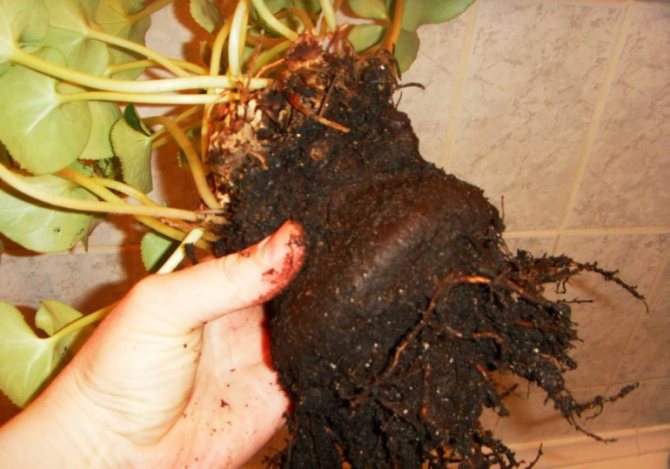

Important: If the size of the pot is increased dramatically, the soil may oxidize, which is harmful to the bulb. To avoid waterlogging of the earthen mixture, holes must be made in the bottom for drainage, if they were not provided initially.
The sequence of actions is as follows:
- A system for draining excess water is laid at the bottom of the pot - pebbles or expanded clay with a layer of 2 cm.Incorrect drainage can cause stagnation of liquid and the death of the plant.
- Prepare the soil mixture.
- Remove the cyclamen from the old pot along with the soil.
- Remove the soil from the tuber, but not completely. Remove dried and soft rotten roots with a sterile knife or nail scissors.
- Place the tuber in the center of the pot.
- Gently straighten the roots so that they do not look out.
- Cover with moistened soil.
- Water the duck in moderation.
Injured healthy roots can cause the bulb to fail to take root.
Why does cyclamen shed leaves, how to save a plant from death?
Cyclamen can shed leaves for several reasons. You can understand whether this is a reason for excitement if you carefully observe the flower. If it begins to turn yellow and wither slowly, and then just as slowly gets rid of old leaves, then it's time for a seasonal rest.... In this case, there are no health problems.
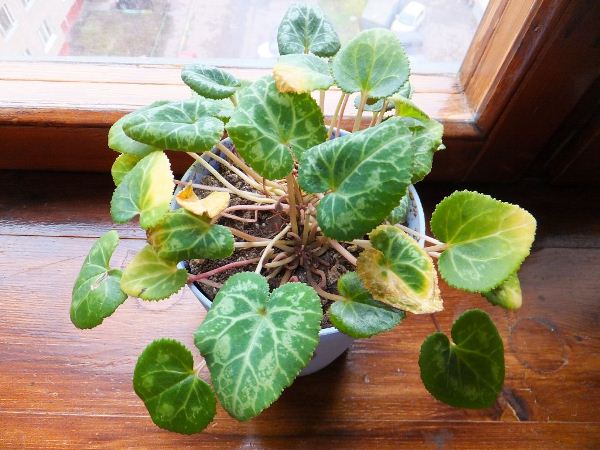

Cyclamen leaves turn yellow
If the branches become bare in a matter of days, then the plant is sick. Why is this happening? Cause may be due to improper care or parasite infestation.... In any case, you should not despair: timely treatment will give a positive result.
Imperfect care during and after flowering
Northeast Africa is considered the homeland of cyclamens. The sunny, humid climate of this part of the world allows the flower to grow to incredible sizes and bloom profusely at the same time. However, it is incredibly difficult to recreate ideal conditions in an ordinary apartment. If this is not possible, the plant turns yellow and sheds its leaves. In this case, you need to analyze what exactly could upset the plant. It could be:
- too high or low air temperature... Cyclamen prefers to grow and bloom at home at 12-17 degrees above zero. In winter, it feels great on glazed balconies, but during severe frosts it is better to bring it into the house.
- improper watering... Most cyclamen varieties have a moderate appetite. They should be watered about once a week, when the substrate is almost completely dry. It is necessary to ensure that the entire earthen lump is moistened without turning into a swamp. Drought is also fatal to the flower. The soil in the cyclamen pot should not be allowed to remain dry for several days;
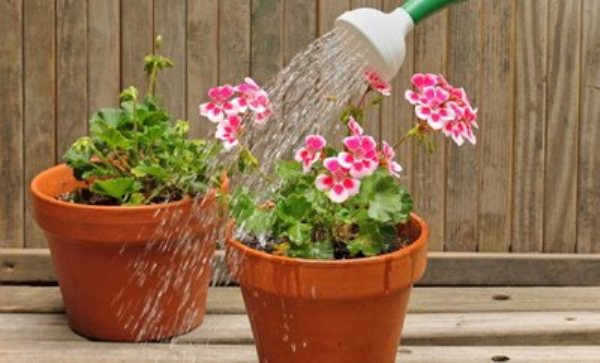

Water the cyclamen once a week.
- direct sunlight... Cyclamen loves diffused light. Rays falling directly on the delicate leaves of the flower can cause burns. The result is yellowing and dropping;
- lack of nutrients... Special fertilizers need to be applied regularly: after transplanting into a new pot, once every two weeks, after the appearance of buds, once a month.
Natural process
Cyclamen is a cyclic plant. After flowering, which can stretch for several months, it retires.... At this time, his leaves also begin to turn yellow and dry. They must be removed by unscrewing them at the base.
A dormant flower is either left in a pot or a tuber is dug up. In the first case, the plant is rearranged in a shaded cool place and watering is severely limited.
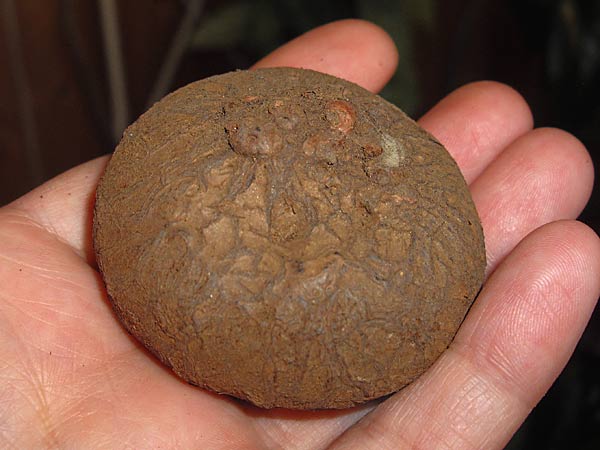

Cyclamen tuber after flowering
In the second the onions are cleaned and stored in a dry, ventilated place at a temperature of 10-25 degrees above zero... They are planted in a new substrate in late summer - early autumn.
Cyclamen can also get sick and shed the leaves due to changes in his life.: after transferring or moving to another place. If the new conditions meet the needs of the plant, then all that is required of the owner is to remove the yellowed leaves and wait for the flower to come to its senses. Of course, without ceasing to carefully look after him.
Plant pests
Yellowed cyclamen leaves may indicate that pests appeared in the flower pot... How to recognize who exactly interferes with the plant's life when it starts to disappear and what to do to revive it, you can from the table.
| Fungi | Fusarium | The plant turns yellow and dries up gradually, the process starts from the tops of the leaves. | The flower is taken out of the pot, cleaned, removes the affected areas of the tuber, treated with fungicide and planted in freshly calcined soil. |
| Gray rot or Botrytis | First, a gray bloom appears on the leaves, and only then they begin to turn yellow quickly. | The affected areas are removed with a sharp blade and the whole plant is treated with a fungicide. | |
| Erwinia | The leaves turn yellow and die off very quickly. | The affected areas are removed with a sharp blade and the whole plant is treated with a fungicide. | |
| Mites | Red tick | A cobweb forms on the underside of the leaves, then the plant turns yellow. | The affected leaves are removed, the cyclamen is treated with an insecticide. |
| Cyclamen mite | The lesion process begins with deformation of the leaves. Having changed their shape, they turn yellow and fall off. | All means are powerless, it remains only to destroy the plant. | |
| Viruses | Bronze of leaves | The leaves are deformed at first, then turn yellow and dry out. | No cure is possible. The flower must be destroyed to prevent contamination of other plants. |
| Ring mosaic | Round light spots form on the leaves, which then crack and turn into holes. |
Description of cyclamen
Cyclamen is a unique perennial plant whose nutrients are found in the tuber. It is he who gives the strength for the growth of the plant. The leaves and flowers are arranged on long stalks, which give the impression that bright, beautiful tropical butterflies soar above the greenery of the cyclamen. Flowers come in a variety of colors: red, white, pink, lilac. Cyclamens with two shades of flowers are often found.
The plant is undersized, even the most adult specimens do not exceed a height of 30 centimeters. The leaves can grow up to 15 centimeters in diameter. A small bush can simultaneously bloom with a huge number of flowers (up to several dozen), which gives it a unique charm. The colors depend on the varieties of cyclamens.
Growing and caring at home, subject to the appropriate requirements and conditions, bring wonderful results of fabulous beauty.
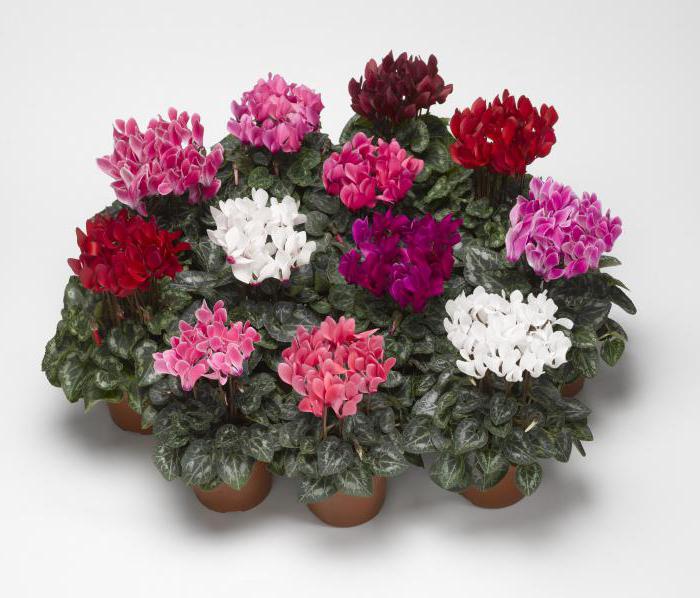

What to do if the cyclamen is sick, how to reanimate a flower
If it was not possible to prevent the disease, the flower began to turn yellow and lose leaves, then you should immediately start treating it. The action plan is as follows:
- Carefully examine the aerial part of the plant and remove all affected areas with a sharp bladeleaving only healthy green tissues. The cut sites are treated with any disinfectant.
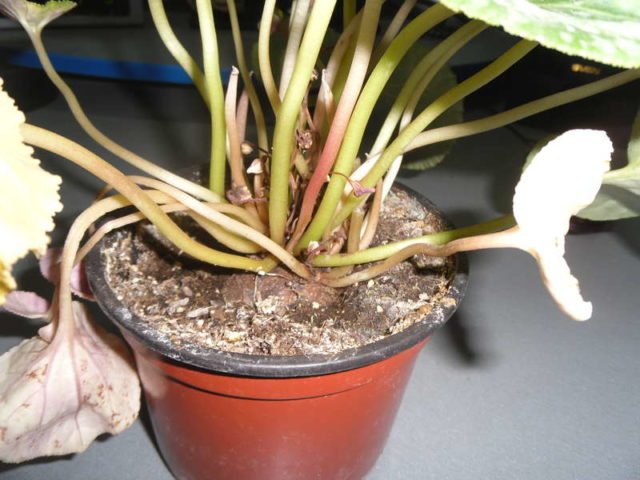

When treating cyclamen, all affected parts are removed
- Now it's the tuber's turn. It is taken out of the ground and also remove all questionable parts.
- The plant is left in a dry, ventilated room for several days to stop possible decay processes;
- Then the flower is planted in a new, pre-calcined ground... It is placed in the shade for several days and watered in moderation. After a week, the plant can be returned to its usual place.
Disease is not yet a verdict for a plant. This is just another, rather difficult, stage in his life. Whether the flower will be able to cope with it depends entirely on its owner. Thanks to perseverance, patience and responsibility, even a weakened plant can be reanimated., so that it will delight you with flowers of stunning beauty for a long time.
Home care
- If the flower was purchased in a store, then it must be transplanted.
- During flowering, cyclamen cannot be transplanted.
- The flower pot should not be large.
- During flowering, feed with complex mineral fertilizers weekly. Cyclamen does not tolerate a lot of nitrogen fertilizers.
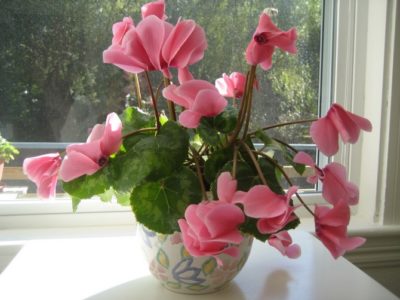

Best suited for this indoor flower are east or west windows in summer, and south windows in winter.- The summer temperature for this flower is between 18 and 22 o C.
- For flowering, cyclamen needs a temperature not higher than 16 ° C.
- Watering should be done in moderation, overflow can be harmful. When watering, do not pour water directly onto the tuber and shoots. Watering is only necessary along the edge of the pot. An hour after watering, the rest of the water must be drained from the pan so that rot does not appear on the roots. Read how to save a flooded cyclamen here.
- At the end of flowering, cyclamens are watered less often, and even less in summer, when the leaves begin to dry.
Main negative factors
Reference. An important aspect is the correct choice of cyclamen when buying.
Initially, you need to pay attention to the condition of the tubers. If the tubers have damage, then it is better not to acquire such a plant. Rot on the roots is also unacceptable. The tubers should be smooth and the leaves should look healthy.
All diseases of indoor flowers, including cyclamens, are divided into two types: parasitic and nonparasitic. The first case is insect damage, and the second is improper care.
Nonparasitic diseases appear for the following reasons:
- Excessive hydration.
- Lack of moisture in a room with cyclamen.
- Incorrectly selected soil.
- Incorrect pot size.
- Bad place for a plant.
Parasitic diseases appear due to pests such as:
- Aphid. The most common pest. It takes away all the juices of the flower, depletes it and leads to deformation of the leaves and stem. If a bloom of white, green, gray was noticed on the leaves, it means that aphids have settled on the cyclamen. To eliminate it, use an insecticide that is sprayed on a flower. After the procedure, the plant must be rinsed under water.
- Thrips. The main difference is their activity. It is not difficult to notice this pest, since they are quite bright. After themselves, thrips leave a silvery tint on the cyclamen. The pest inhibits the growth of leaves, as a result of which they can fall off. You can destroy the enemy using special adhesive tape or insecticide.
- Cyclamen mite. Almost invisible to human eyes, because it has a very small size. The parasite develops on the inside of the leaf. It looks like the leaves are covered in dust. You can get rid of it with the help of chemical antiseptics.
What causes the leaves to turn yellow?
If it was noticed that the foliage turns yellow in cyclamen, then the reasons may be associated not only with improper care, but also with the presence of pests or natural processes. It is worth dwelling in more detail on the possible reasons for the appearance of yellow leaves on a plant. First of all, it should be said about the wrong temperature regime. The optimal temperature for cyclamen is considered to be + 18 ... + 24˚С in summer and + 12 ... + 14˚С - in winter. If the temperature exceeds the specified limits, then the leaves of the plant may begin to turn yellow. If in this case no measures are taken, then the plant may die altogether. Cyclamen should not be placed near a working heating system or other heat sources.If the optimum temperature rises by more than 5 ° C, you need to move the flower to another place, for example, to a balcony, insulated veranda.
Another reason for yellowing can be improper lighting of the plant. It should be borne in mind that cyclamen does not like direct sunlight: it needs bright, but diffused light. If necessary, you will need to organize protection from the daytime sun. It is best to place the flower on the western and eastern windows. It is possible to judge that the cyclamen was damaged by sunlight by the characteristic yellow spots on the leaves. If such a problem has been identified, the plant needs to be moved immediately to a place protected from the bright sun, which will prevent damage to healthy foliage.
Leaves on a flower can also turn yellow with improper watering and moisture levels. During the flowering period, the plant requires regular but moderate watering. At rest, cyclamen is rarely watered and in small quantities. The basic rule is not to overmoisten it. In addition, water should be avoided on the tubers. If this is neglected, the root system of the flower rots rather quickly, the leaves turn yellow, which will lead to the death of the flower.
It is worth considering that cyclamen requires high air humidity during the heating period. You can ensure the required moisture level by placing the plant in a suitable container with wet expanded clay or pebbles. Another option is also possible: spray the air around the cyclamen from a spray bottle (spray bottle for flowers), while water droplets should be avoided on the leaves, which can lead to yellowing. If such a problem is observed, then the tuber should be inspected: if there are putrefactive spots, they are removed, the cut sites are sprinkled with charcoal and dried. After the plant is transplanted into a new container, the watering regime and temperature are observed.
Top dressing and rest period
In addition to the above reasons, the problem of yellowing leaves can be associated with improper fertilization. So, when applying dressings with a high nitrogen content, the effect under consideration is possible. In addition, an excessive amount of nutrients can lead to an increase in the tuber, which makes it more vulnerable to various diseases. Lack of fertilizer, as well as excess, negatively affects the state of cyclamen: the plant will simply get rid of excessive amounts of foliage. In this case, the amount of leaves that the plant can provide with nutrients will remain. This suggests that the flower needs to be fed during flowering and active growth. As fertilizers, liquid mineral dressings are used, which are diluted 2 times and applied once every 2 weeks. During the dormant period, the plant does not need additional nutrition.
It is worth dwelling on the dormant period in more detail, since in cyclamen it is strongly pronounced and begins after flowering. As a rule, it falls in the spring and summer. This time is characterized by a gradual yellowing of the foliage, followed by drying and falling off. Thus, the plant prepares itself for rest. But nevertheless, flower growers cannot but worry about the question of when the leaves of cyclamen turn yellow, what to do in this case. In such a situation, the dried foliage is cut off from the flower, the amount and volume of watering is reduced, but not immediately, but gradually. In addition, fertilization should be stopped, and the pot should be moved to a room with a lower temperature and no light. Such, for example, can be a basement. In the middle of summer, the cyclamen should be returned to its previous conditions, watering should be increased as new leaves appear.
Diseases and pests
Like other plants, cyclamen can be attacked by pests. The main ones are:
- thrips;
- cyclamen ticks;
- shield.
Pests such as thrips are small insects (about 1.5 mm) that damage almost the entire plant: stem, leaves, flowers, and then move to the ground. When the larvae become adults, they acquire wings and get out of the ground. Whether or not there are thrips on a flower can be judged by light spots or dots. The cyclamen leaves at the same time acquire a silvery sheen. To combat the pest, insecticides such as Aktara, Actellik and soap solution are used.
The most common pests include the cyclamen mite. Its peculiarity is its very small size. The main habitat is the lower part of the foliage. As a result of damage to the flower by a tick, the leaves of the plant are deformed and curled, growth slows down, and the buds themselves wither or acquire an irregular shape. Treatment involves the use of insecticides, such as Aktara, Fufanon. As for the scale insect, the presence of a pest on the plant can be judged by brown spots both on the leaves and on the stem. Insecticides and soap solution are used to combat.
Of the diseases, first of all, it is worth noting gray rot, which belongs to fungal and is capable not only of infecting the entire plant, but also of ruining it. Pathology manifests itself in the form of a gray plaque, and the damaged areas become soft. As soon as the first signs of the disease were noticed, systemic fungicides should be applied immediately, damaged parts of the plant should be removed, the flower should be transplanted into a new soil, and the room itself should be ventilated. It is recommended to reduce the number of watering and spraying. It is better to moisturize in the morning, so that the soil dries up during the day.
Cyclamen is also exposed to late blight. The disease manifests itself in the form of drying leaves and peduncles. If you do not take any measures, then the plant will simply die. The cause of late blight is too wet soil. Fight with fungicides, such as Oxyhom. Another fungal infection is Rhizoctonia rot. In case of damage, the plant can die as soon as possible. The appearance of the disease is indicated by soft spots on tubers, leaves and stems. The main reason is too wet soil together with high temperatures. For treatment, you should stop watering and apply Oxyhom or other fungicides.
How to cure cyclamen?
Before you start treating a flower, you need to find out why the leaves of cyclamen turn yellow. To do this, you need to adhere to the following sequence of actions:
- The pot is inspected for various kinds of violations. These include, for example, too wet or, conversely, dry soil. Particular attention should be paid to the smell of the substrate. The soil should not emit a putrid, sour or moldy odor.
- The visible deviations in the life of the plant are determined according to the above reasons.
After determining the cause, further manipulations should be aimed at eliminating the problem. If it all comes down to improper care, then you just need to provide the appropriate conditions for the normal growth of the plant. If diseases or pests are detected, a number of the following manipulations will be required:
- remove damaged foliage;
- perform treatment with insecticides or fungicides;
- transplant the plant into a new container;
- after transplantation, it is recommended to treat the flower with preparations such as Fitoverm, Agravertin, and insecticidal soap.
As one could understand, a number of reasons can lead to the appearance of yellow leaves on cyclamen, among which improper care, diseases and pests stand out. In order for a plant to delight with its beauty, it is necessary to provide appropriate conditions, which does not require much effort and time.
sadovod.
Leaves fall
Yellowing and falling of leaves in cyclamen may indicate a high temperature and insufficient lighting of the room where it is located. Also, cyclamen leaves begin to dry, curl and fall off due to dry air, insufficient or excessive watering.
Another reason is the presence of pests, such as spider mites. Finally, leaf fall may indicate a natural process of preparation for the dormant period. In this case, it is not scary.
If the cyclamen begins to shed leaves, it is important to determine the cause.
If this is the wrong care, the conditions of detention should be optimized.
For example, put the pot in a place with good diffused lighting, provide the required temperature and humidity, and adjust watering. If the cyclamen is infected with pests, treatment with insecticides is necessary: Aktellik, Fitoverm, Akarin.
Knowing the causes of yellowing, dropping and curling of leaves in cyclamen, it is much easier to both prevent the problem and fight it. And all the necessary chores are fully compensated for by the amazing appearance and bright flowering!
Like multi-colored butterflies flutter over a thick cap of bright green leaves: a little higher, a little lower, and one butterfly even sat down to rest on a leaf. This cyclamen is an unusual plant that is loved by flower growers all over the world for its amazing beauty. The cyclamen is so beautiful that many famous poets and writers sang the tender flower in their works: Sologub, Olesha, Voznesensky, Voloshin, Pasternak, Ehrenburg.
... Love is cruel and harsh.
And the pain of betrayal is inevitable.
I will only trust the flowers again
Falling into the arms of a cyclamen ...
The people call cyclamen (lat. Cýclamen) alpine violet, and also dryad and pork bread (the name comes from the fact that the roots of cyclamen are very fond of wild boars). In fact, the correct name for the plant suggests an emphasis on the first syllable - cyclamen, and the generally accepted pronunciation came to us from the French language.
Cyclamen is a perennial bulbous plant of the primrose family (Latin Primulaceae), with beautiful patterned heart-shaped leaves and single flowers on long pedicels. Flowers, up to 8 cm in diameter, have five petals and can be white, pink, purple, lilac and even purple in color.
Cyclamen surprises not only with its beauty, but also with a pleasant, delicate scent. Alpine violet scent is used in many perfume compositions: Weekend for Women Burberry, Cumbia Colors Woman Benetton, Delight Oriflame, Armani Code Sheer Giorgio Armani and so on.
The genus of cyclamens has more than twenty species of plants, differing in appearance: standard (25-35 cm), medium-sized (15-25) and undersized (up to 15 cm), which can bloom with both simple and double flowers.
Wild cyclamens can be found all over the world in places with warm and humid climates: the Mediterranean, the Caucasus, Northeast Africa, the Middle East. The natural habitat of a flower can often be recognized by the name of the species: African, Cypriot, Persian, Colchis, Grekum, and so on.
Plant breeding and hybridization began in the 19th century, and since then, the flower has new fans every day around the world. However, despite the great variety of cyclamens in nature, only a few of them are adapted to indoor growing conditions.
Air humidity level
This is another important factor that affects the comfort of cyclamen. Particular attention should be paid to air humidity during the heating season. Heating devices are known to dry out the air, which worsens the condition of the plants. In cyclamen, a lack of moisture can be manifested by yellowing of the leaves.
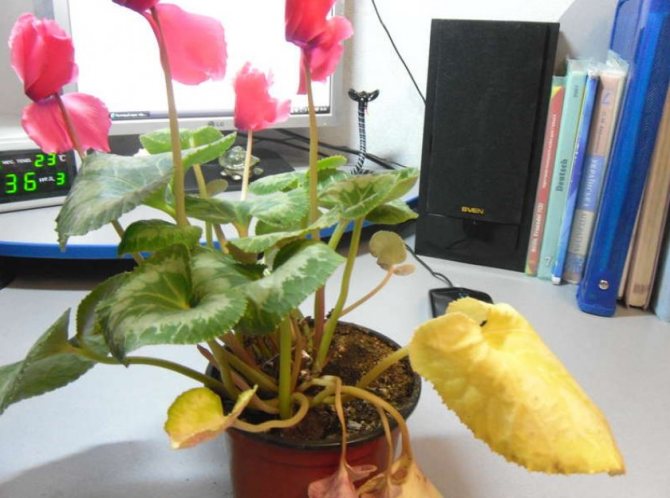

It turns out that the harm to the cyclamen is often caused not by the heating, but by the housewives themselves. The mistake is that they try to moisturize the plant and often spray the foliage.As a result, water, getting into the leaf outlet, stagnates and provokes the appearance of rot. The leaves begin to turn yellow and then wither.
It is not necessary to increase the humidity too actively. It is enough to place a vessel filled with water next to the plant.
Pests
A change in the color and shape of greenery is most often triggered by the appearance of pests on the plant. There are three types of parasites:
- Thrips;
- Cyclamen tick;
- Aphid.
Thrips are flying insects, if they are not eliminated in time, they can scatter throughout the grower's collection. On cyclamen infected with thrips, silvery paths left by winged creatures appear. The pet begins to wither, spots appear on the flowers. Greens acquire a faded brown tint or even lose their color. To all the trouble, phyto-pests give off a sticky consistency.
Treatment measures: use of insect-attracting trap tapes. Frequent spraying with chemicals, as well as irrigation of the air next to the pot.
The cyclamen mite accentuates its stay on the lower tender sides of young shoots. With a large accumulation, it looks like a dust deposit. With a tick, the buds fall off, the stems twist, the edges of the leaves curl.
Treatment measures: complete removal of damaged parts. Spraying with pest repellent and irrigation of soap and ash infusion.
Aphids prefer young shoots and buds. With aphid bloom, the leaves are wrapped in tubes, the bush is covered with sticky mucus. The inflorescences stop blooming, and the greens lose their color. A sooty mushroom may take root. They fight aphids with cotton pads soaked in a chemical substance, spray and rinse with a direct stream of water.
The reasons
Usually it is not difficult to care for a cyclamen, but sometimes a flower in a pot withers and withers. The main reason is the illiterate care of a pet, and if you do not react in time, the plant dies in a matter of days.
When you notice that a flower has a bad appearance and has begun to wilt, the reasons may be as follows:
- If the leaves wilted after your pet was moved to the apartment, then this indicates that the cyclamen is tolerating stress. Basically, this condition occurs due to sudden changes in temperature or humidity.
- In some cases, the flower withers due to a lack of mineral supplements. Cyclamen must be fertilized during an intensive period of growth, it is during this period of time that the plant needs additional feeding more than ever.
- Also, the plant may wilt after purchase, when the cyclamen enters a dormant state. Many inexperienced growers think that the plant has died and are thrown away.
Why cyclamen does not bloom, but withers - this happens due to non-compliance with the rules for care. For example, a flower dies from excessive moisture or high air temperatures. If you do not adhere to the correct care, then the plant begins to wilt.
The flower is very whimsical to the water with which it is watered. Experts recommend using soft and settled water at room temperature when watering. In addition, care should be taken to ensure that the air in the room is slightly humidified. Water the plant in moderation, the cyclamen does not like overflow, otherwise it can negatively affect the general condition.
It is also necessary to inform that the flower does not tolerate too salty soil. This happens if you over-apply mineral fertilizing. In very salty soil, the plant dies over time. Also, the plant withers quite often due to diseases.
If the whole flower withers, how to treat it?
If you are late with timely care and the flower began to wither, turn yellow and lose leaves, then you should immediately begin to reanimate it. This requires:
- First, carefully examine the aerial part of the flower and remove all dry, non-living affected parts.
- Treat the cut sites with any disinfectant.
- Then wash the tubers from the ground and, if necessary, also carefully remove all questionable parts.
- Treat the tubers with Topaz or another fungicide.
- Then dry the roots and plant the flower in fresh, pre-calcined ground.
- Put in a dark place for a few days, remembering to water in moderation.
- After a week it can be returned to its usual place.
Read about the reasons why a flower withers and leaves dry in it, read this article.
Description and structure of the plant
Cyclamen is a herbaceous perennial plant with a hard, thickened root. The leaves of the plant are round or heart-shaped, dark green in color with interesting silvery or white patterns.
In flowers, petals are bent back and can have a very varied color. Cyclamens bloom from October to March crimson - red, pink and white, purple buds. The lifespan of one flower is about ten days.
Important! Cyclamen is a poisonous plant. Its tubers contain a substance that can irritate or inflame the skin.
Features of care for the seasons
Among the rules of care, one can single out the key ones, classified by the seasons:
- Fall - rapid growth of the flower (the appearance of young leaves, the laying of future buds). You can transplant the plant. Watering is good, observe high humidity.
- Winter - flowering. Observe medium watering and air humidification. Removal of faded parts of the plant.
- Spring - preparation for the dormant period (wilting of leaves, exposure of tubers). Reduce watering, cut off dried leaves.
- Summer - the dormant period of the alpine violet. Cut off all the tops, remove to the basement, or other dark, damp place, water occasionally.
Cyclamen is a poisonous plant. Wear rubber gloves when handling it and grow it away from children and pets.
Cyclamen is an amazingly beautiful houseplant. If his leaves turn yellow, it is necessary to find the cause and eliminate it. Then the grateful flower will delight the eye on long winter days.
Problems in growing cyclamen
Everyone who has ever encountered the cultivation of cyclamens wondered why the leaves of a plant periodically turn yellow - this problem continues to be the most intractable and incomprehensible for many. It is worth saying that the cause of any problem is improper care of the plant. Therefore, it is important to know how to provide the plant with comfort in indoor conditions.
If you notice that the cyclamen suddenly turned yellow, and the flowers remain healthy and strong, then the reason is most likely excessively dry warm air. This plant does not tolerate temperatures above seventeen degrees. A lack of liquid or direct sunlight can also contribute to a sharp yellowing.
Rotting leaves and peduncles, which can generally lead to the death of cyclamen, is another problem. Here the reason is the waterlogging of the soil, especially if water gets on the upper part of the tuber. In no case do not water the sprout part of it - do the watering as carefully as possible.
Sometimes cyclamens have a short flowering period, which can provoke dry air, too high an air temperature or poor watering. There can be many reasons here, and it can be difficult to identify one. Most importantly, do not forget to feed the plant throughout the growth period as well as during flowering.
And finally, leaf deformation. Typically, this is due to aphid or mite infestation. As soon as you notice that pests have appeared, start washing the cyclamen, or rather, its leaves, with a special insecticidal soap. Alternatively, use an animal-friendly soap. In addition, spray the plant with special preparations, for example Fitoverm or Agravertin - they are odorless and will not negatively affect the cyclamen.We will talk about how to prevent the appearance of ticks later, but for now we will give some tips for caring for cyclamen.
Sunburn
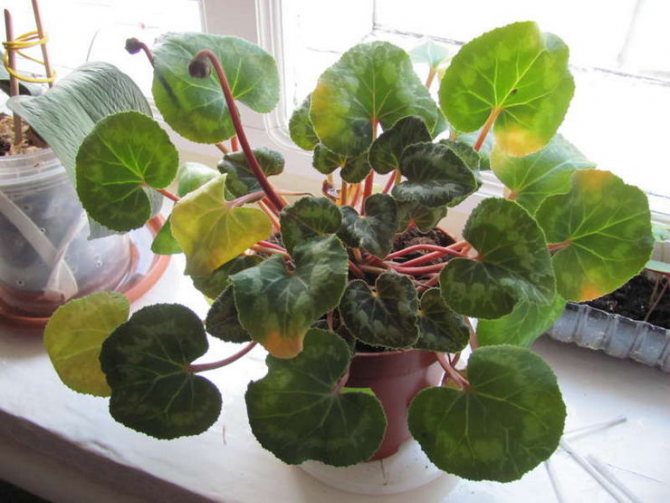

Warm and gentle rays of the sun can also cause yellowness on the leaves. Cyclamen prefers to grow in partial shade, in places with bright diffused light and no direct sunlight. The rays of the sun, when they hit the leaves, burn them and leave stains - burns.
Experienced growers recommend finding a growing place for cyclamen where the plant will be protected from the midday sun. Avoid placing the flowerpot very close to the glass on the windowsill.
Sunburn on leaves is different from other spots. They do not increase in size and do not spread to other areas of the leaf. If you rearrange the culture in a penumbra without direct sun, then new spots will not appear.
Content during dormancy
After active flowering, which lasts three to four months, the cyclamen rests for some time. Withered buds with pedicels must be separated from the tubers with neat jerks, turning the sprouts. Persian varieties "fall asleep" for two months - flowering stops, the leaves curl, turn yellow, wither, the plants discard them. This happens towards the end of April. During dormancy, watering should only slightly feed the dormant tuber with moisture so that rot does not form. Cyclamen is transplanted by careful transfer of the clod into a pot with sand drainage and peat filler and left for summer holidays in the form of a tuber slightly protruding above the soil surface.
European cyclamen falls asleep for the winter, but at the same time does not lose its decorative appeal. Beautiful green leaves remain on the tuber, which it does not shed. At this time, you should ensure proper watering and care, rearrange the pot to the south side of the house, and top dressing can begin in March. Cyclamen is transplanted after a dormant period, but before flowering - then there will be an abundant number of flowers (up to 80 buds).
Faced with the problem of what to do if the leaves turn yellow, begin to curl and fall off, amateur flower growers think that cyclamen is a capricious plant, very demanding to care for. Subject to the recommendations for the care and maintenance of problems with yellowed leaves do not arise.
Methods for dealing with yellowing leaves
The sources of the unhealthy type of cyclamen have been identified, now we need to take up the eradication of the misfortune with the flower.
Elimination of human-induced causes
Lighting for cyclamen should be chosen wisely. On the southern windows, under the scorching midday sun, the leaves will bother and dry up. If there is no other way out, only as the south side, then it is necessary to shade the window in the midday heat. For active growth, the east or west side is suitable. It will also be uncomfortable on the north side - a lack of light can have a detrimental effect.
The air supply for the inhabitant of the window sill must be constant. It is necessary to ventilate the room, but so that there are no drafts and direct wind streams. During winter airing, the plant is covered with a covering material.
It is necessary to ensure that the alpine violet does not dry out, that is, water it often, but not to the "swamp", and even better, put pebbles in the pallet and pour water into it, then the earth does not become waterlogged, the roots will not rot.
The temperature at which it is comfortable for a quivering sprout to exist is 12-200C. If the degree is exceeded, the leaves turn yellow and the flowers wither, then it is more advisable to remove the pot to a cooler place.
Mold on the ground and unpleasant odors are the result of heavy watering. In this case, to save the cyclamen from certain death - transplant. When relocating, it is necessary to completely change the land. Sterilize the old pot, but it is better to buy a new one.
Activities for the return of a healthy appearance, due to reasons beyond human control
A change of residence from the shelves of the showcase to the window sill can provoke leaf falling, slowing growth. This is due to the fact that the Alpine violet was in greenhouse conditions in the store. The bush was fertilized with various preparations and additives for abundant discarding of buds and rapid growth.
First of all, a new copy of the collection should be transplanted from the purchased soil into the prepared land. When transplanting, carefully examine the tuber for mold, damage and root condition.
Also, the color of the green plumage of the tuber is a consequence of depleted land and lack of nutrients. It is necessary to feed at the time of bud formation and the entire flowering period. However, it should be borne in mind that an excess of feeding can adversely affect the flower.
In addition to all of the above, the leaves may turn yellow from the fact that the pet simply retires. In this case, the seedling should not be touched, but watering should be reduced to a minimum and moved to a cool, dark room. Water once a month and do not disturb until the end of summer.
The most unpleasant culprits in the wilting of "pig bread" are pests. The main thing is to notice them in time and prevent them from spreading to the entire area. They are eradicated by traditional methods of irrigation with infusions and chemicals.

